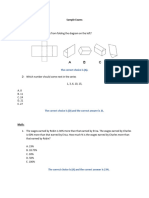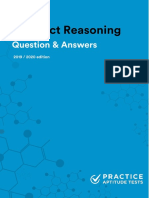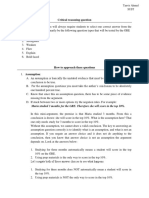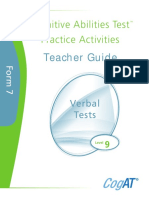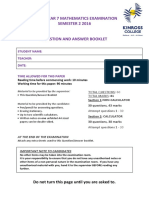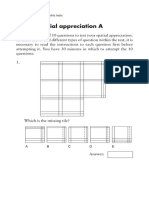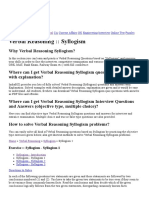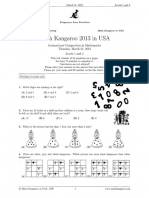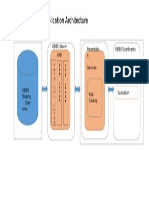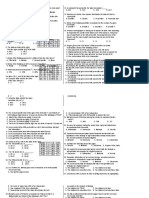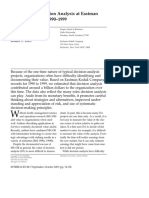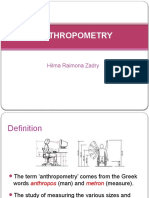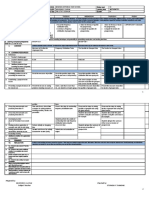0 ratings0% found this document useful (0 votes)
417 viewsCognitive Abilities Test: Cogat
Cognitive Abilities Test: Cogat
Uploaded by
Srinivas KankanampatiThis document provides an overview of the Cognitive Abilities Test (CogAT), which is administered to students in grades 2-3 and 5-6. CogAT measures learned reasoning and problem-solving skills in three areas: verbal, quantitative, and nonverbal. It does not measure factors like effort, attention, or work habits. District 34 uses CogAT scores as part of identifying gifted students and for accelerated math placement. CogAT includes sample questions and explains how scores are reported using standard age scores, percentiles, and stanines.
Copyright:
© All Rights Reserved
Available Formats
Download as PDF, TXT or read online from Scribd
Cognitive Abilities Test: Cogat
Cognitive Abilities Test: Cogat
Uploaded by
Srinivas Kankanampati0 ratings0% found this document useful (0 votes)
417 views11 pagesThis document provides an overview of the Cognitive Abilities Test (CogAT), which is administered to students in grades 2-3 and 5-6. CogAT measures learned reasoning and problem-solving skills in three areas: verbal, quantitative, and nonverbal. It does not measure factors like effort, attention, or work habits. District 34 uses CogAT scores as part of identifying gifted students and for accelerated math placement. CogAT includes sample questions and explains how scores are reported using standard age scores, percentiles, and stanines.
Original Title
CogAT presentation.pdf
Copyright
© © All Rights Reserved
Available Formats
PDF, TXT or read online from Scribd
Share this document
Did you find this document useful?
Is this content inappropriate?
This document provides an overview of the Cognitive Abilities Test (CogAT), which is administered to students in grades 2-3 and 5-6. CogAT measures learned reasoning and problem-solving skills in three areas: verbal, quantitative, and nonverbal. It does not measure factors like effort, attention, or work habits. District 34 uses CogAT scores as part of identifying gifted students and for accelerated math placement. CogAT includes sample questions and explains how scores are reported using standard age scores, percentiles, and stanines.
Copyright:
© All Rights Reserved
Available Formats
Download as PDF, TXT or read online from Scribd
Download as pdf or txt
0 ratings0% found this document useful (0 votes)
417 views11 pagesCognitive Abilities Test: Cogat
Cognitive Abilities Test: Cogat
Uploaded by
Srinivas KankanampatiThis document provides an overview of the Cognitive Abilities Test (CogAT), which is administered to students in grades 2-3 and 5-6. CogAT measures learned reasoning and problem-solving skills in three areas: verbal, quantitative, and nonverbal. It does not measure factors like effort, attention, or work habits. District 34 uses CogAT scores as part of identifying gifted students and for accelerated math placement. CogAT includes sample questions and explains how scores are reported using standard age scores, percentiles, and stanines.
Copyright:
© All Rights Reserved
Available Formats
Download as PDF, TXT or read online from Scribd
Download as pdf or txt
You are on page 1of 11
Cognitive Abilities Test
CogAT
Parent Overview
When is CogAT administered
2009-10
3rd grade
6th grade
Proposed to begin spring 2010
2nd grade
5th grade
What does CogAT measure?
CogAT measures learned reasoning and problem-solving
skills in three different areas: verbal, quantitative, and
nonverbal.
Reasoning skills develop gradually throughout a persons
lifetime, and at different rates for different individuals.
CogAT does not measure such factors as effort, attention,
motivation, and work habits, which contribute to school
achievement as well.
How do the three batteries of
CogAT differ?
The Verbal Battery measures a childs ability to remember and
transform sequences of English words, to understand them, and
to make inferences and judgments about them.
The Quantitative Battery tests the child's understanding of
basic quantitative concepts and relationships that are essential
for learning mathematics. Tasks measure both the understanding
of relational concepts and the students ability to discover
relationships and to figure out a rule or principle that explains
them.
The Nonverbal Battery measures reasoning using pictures and
geometric shapes. This reduces the impact of language on the
student's score. The Nonverbal Battery also appraises the
students ability to use her/his cognitive resources in new
situations.
Sample Verbal Battery
Questions
Primary Level
Intermediate Level
Sample Non-Verbal Battery
Questions
Primary Level
Intermediate Level
Sample Quantitative Battery
Questions
Primary Level
Intermediate Level
How is CogAT data used?
District 34 uses CogAT test results as part of the the screening step of the
identification process for the gifted program and as part of the data used to
help identify students for accelerated math
CogAT is only one of the data points used
during these processes. District 34 does not
make decisions about students based on a
single data point.
CogAT scores can be used by classroom teachers
CogAT data provides a measure of each students level of cognitive
development that captures important information not represented in school
grades
Growth data from assessments such as NWEA and CBM provide teachers
with information about what students have learned that is useful in planning
instruction
Glossary of Scoring Terms
Standard Age Score (SAS) is a normalized standard score, with a
mean (average) of 100. Standard Age Scores of 89-111 are all
within the average range.
Percentile Rank indicates the percentage of students in the same
age or group whose scores fall below the score obtained by a
particular student
A student with a SAS of 100 on the Verbal Battery has the
rate and level of development of verbal reasoning skills that
are typical for his age group
A student with a SAS of 125 on the Verbal Battery has a
faster rate and higher level of development of verbal
reasoning skills than the typical student in his age group
Percentile ranks of 24th through 76th are in the average range
Stanine is a normalized standard score scale consisting of nine
broad levels (1-9). Stanines are broad groupings of percentile
ranks.
Interpreting Percentile Ranks
and Standard Age Scores
Standard Age
Score
Percentile
Very High
128-150
96th-99th
Above Average
112-127
77th-95th
89-111
24th-76th
73-88
5th-23rd
Average
Below Average
You might also like
- Mathematics in The Modern World Answer Key PDFDocument2 pagesMathematics in The Modern World Answer Key PDFPrincess Lozada57% (7)
- Numeracy Professional Skills TestDocument26 pagesNumeracy Professional Skills TestTony Akpan100% (1)
- CogatDocument11 pagesCogatHorace Batiste67% (3)
- Verbal Reasoning: For NTSE, olympiads & competitive examsFrom EverandVerbal Reasoning: For NTSE, olympiads & competitive examsRating: 5 out of 5 stars5/5 (2)
- IntelligenceDocument31 pagesIntelligenceKhalid Saif Jan100% (1)
- OLSAT8 Online Guide in Setting Up The DeviceDocument6 pagesOLSAT8 Online Guide in Setting Up The DevicecNo ratings yet
- Cogat Sample Test: Cognitive Abilities Test Grades K-8Document16 pagesCogat Sample Test: Cognitive Abilities Test Grades K-8BabuNo ratings yet
- Making Number Talks Matter-Resources by Chapter: Ch. 1 What Are Number Talks? Why Are They So Important?Document10 pagesMaking Number Talks Matter-Resources by Chapter: Ch. 1 What Are Number Talks? Why Are They So Important?Mustafa Mohammed0% (1)
- Practice Activities Verbal Level 12Document3 pagesPractice Activities Verbal Level 12Srinivas KankanampatiNo ratings yet
- GCE O Level Maths Paper 1 2019Document6 pagesGCE O Level Maths Paper 1 2019Anne marie Nzemboung100% (1)
- Missouri Department of Transportation Speed Study For Gravois Avenue/Route 30 Gravois - City of St. LouisDocument12 pagesMissouri Department of Transportation Speed Study For Gravois Avenue/Route 30 Gravois - City of St. LouisnextSTL.comNo ratings yet
- Pre Test Grade 10 MathDocument5 pagesPre Test Grade 10 MathDina ValdoriaNo ratings yet
- Non verbal reasoning: for NTSE,olympiads & competitive examsFrom EverandNon verbal reasoning: for NTSE,olympiads & competitive examsRating: 4.5 out of 5 stars4.5/5 (6)
- BLOM Bank - Sample ExamsDocument2 pagesBLOM Bank - Sample Examstrailsumma72No ratings yet
- Ada 221448 Raven's Matrices PaperDocument70 pagesAda 221448 Raven's Matrices PaperRemik Buczek100% (1)
- Numerical ReasoningDocument3 pagesNumerical Reasoningvalea_neagraNo ratings yet
- Cogat7 On The Road4Document62 pagesCogat7 On The Road4MandarNo ratings yet
- General Ability Test - IntructionDocument2 pagesGeneral Ability Test - Intructionapi-19473489No ratings yet
- Logical Reasoning AbilitiesDocument7 pagesLogical Reasoning AbilitiesGulEFarisFarisNo ratings yet
- Results: Your Score: 90%!Document9 pagesResults: Your Score: 90%!redditor1276No ratings yet
- Non Verbal Reasoning Complete Reference Guide - Guide4BankExamsDocument28 pagesNon Verbal Reasoning Complete Reference Guide - Guide4BankExamsShiv Ram Krishna83% (6)
- Written ExpressionDocument11 pagesWritten ExpressionHafida HaffidaNo ratings yet
- Verbal Reasoning PDFDocument13 pagesVerbal Reasoning PDFlakshmananNo ratings yet
- Condensed Guide For The StanfordDocument66 pagesCondensed Guide For The StanfordbrunitarocchiNo ratings yet
- DyscalculiaDocument3 pagesDyscalculiatini0211No ratings yet
- Abstract Reasoning TestDocument9 pagesAbstract Reasoning TestrjNo ratings yet
- Abstract Reasoning Questions & Answers - Page 6Document8 pagesAbstract Reasoning Questions & Answers - Page 6xyonieNo ratings yet
- Visual ReasoningDocument12 pagesVisual ReasoningsamdhathriNo ratings yet
- Management Aptitude TestDocument9 pagesManagement Aptitude Testrajesh palNo ratings yet
- Critical Reasoning Question TypesDocument3 pagesCritical Reasoning Question TypesNazmul HasanNo ratings yet
- Rat & Wais TestsDocument19 pagesRat & Wais TestsEng Ansam OmariNo ratings yet
- Problem Solving ExamDocument3 pagesProblem Solving ExamMigs MlaNo ratings yet
- Cogat Scores So What Do They MeanDocument8 pagesCogat Scores So What Do They Meanapi-401521800No ratings yet
- Cognitive Abilities Test Practice Activities: Teacher GuideDocument16 pagesCognitive Abilities Test Practice Activities: Teacher GuideZoon AANo ratings yet
- Verbal and Nonverbal ReasoningDocument60 pagesVerbal and Nonverbal ReasoningMyla Guindayan67% (3)
- Chapter 2 For Preoral 2Document46 pagesChapter 2 For Preoral 2AzahleaNo ratings yet
- Iq TestDocument18 pagesIq TestAmrita BawaNo ratings yet
- Abstract ReasoningDocument26 pagesAbstract ReasoningMs. 37o?sA100% (1)
- Year 7 Maths Exam Sem 2 2016Document20 pagesYear 7 Maths Exam Sem 2 2016Rachanee UngrangsiNo ratings yet
- Spatial Elements Examination 37: Description - InstructionsDocument20 pagesSpatial Elements Examination 37: Description - Instructionskshitiz tiwariNo ratings yet
- Math Numerical ReasoningDocument20 pagesMath Numerical ReasoningDael Gerong100% (1)
- NVR Sample PaperDocument10 pagesNVR Sample PaperAhmad ShakirNo ratings yet
- Scores of High Range TestsDocument6 pagesScores of High Range TestsRemik BuczekNo ratings yet
- Sample Wiscv2Document8 pagesSample Wiscv2Jwan Delawi100% (1)
- The Verbal Reasoning Test Part I: The Principle of ComplianceDocument7 pagesThe Verbal Reasoning Test Part I: The Principle of ComplianceCorben DallasNo ratings yet
- Test 1: Spatial Appreciation A: 22 IQ and Psychometric TestsDocument24 pagesTest 1: Spatial Appreciation A: 22 IQ and Psychometric TestsNugi100% (1)
- Abstract ReasoningDocument15 pagesAbstract ReasoningJethro BangananNo ratings yet
- Add DecimalsDocument1 pageAdd DecimalsMathsStarNo ratings yet
- NVR Familiarisation Parent Guide PDFDocument8 pagesNVR Familiarisation Parent Guide PDFKlairine MarianaNo ratings yet
- Parts of An IQ TestDocument13 pagesParts of An IQ TestRizi AlconabaNo ratings yet
- 20min Version RapmDocument9 pages20min Version RapmvanndaNo ratings yet
- Numeracy Practice Paper 3Document39 pagesNumeracy Practice Paper 3James KlsllNo ratings yet
- Aptitude Test 5Document3 pagesAptitude Test 5Madz Rj MangorobongNo ratings yet
- Non Verbal Reasoning QuestionsDocument24 pagesNon Verbal Reasoning Questionsrejujoel4655100% (2)
- Percent Ratio and Rate Unit PlanDocument4 pagesPercent Ratio and Rate Unit Planapi-485170066No ratings yet
- Tema 3 QrsDocument2 pagesTema 3 Qrsapi-344635191No ratings yet
- How To Tackle Math Olympiad QuestionsDocument8 pagesHow To Tackle Math Olympiad QuestionsKaushal KumarNo ratings yet
- Method For Verbal ReasoningDocument11 pagesMethod For Verbal Reasoningnabhan07No ratings yet
- Syllogism - Verbal Reasoning 2Document5 pagesSyllogism - Verbal Reasoning 2Iqbal HossainNo ratings yet
- Spatial Ability QuestionsDocument10 pagesSpatial Ability QuestionsNguyễn Huy BìnhNo ratings yet
- How To Solve Cubes and Dice Problems Part 1Document9 pagesHow To Solve Cubes and Dice Problems Part 1Chintan RavalNo ratings yet
- Test of Reasoning 8Document8 pagesTest of Reasoning 8Samir JainNo ratings yet
- How To Pass Advanced Numeracy TestsDocument224 pagesHow To Pass Advanced Numeracy TestsNguyen Minh100% (1)
- How To Solve - Learn Analytical Reasoning Questions in Test - QuizDocument10 pagesHow To Solve - Learn Analytical Reasoning Questions in Test - QuizHajra QadirNo ratings yet
- 2013 Math KAngaroo PDFDocument24 pages2013 Math KAngaroo PDFSrinivas KankanampatiNo ratings yet
- Awsgsg Wah LinuxDocument40 pagesAwsgsg Wah LinuxSrinivas KankanampatiNo ratings yet
- Lambda DGDocument356 pagesLambda DGSrinivas KankanampatiNo ratings yet
- Cloudformation UgDocument1,380 pagesCloudformation UgSrinivas KankanampatiNo ratings yet
- Cloudformation UgDocument1,380 pagesCloudformation UgSrinivas KankanampatiNo ratings yet
- Practice Activities Quantitative Level 12Document5 pagesPractice Activities Quantitative Level 12Srinivas KankanampatiNo ratings yet
- Practice Activities Quantitative Level 8Document7 pagesPractice Activities Quantitative Level 8Srinivas KankanampatiNo ratings yet
- CogAT 7 DAforOnlineTesting L5-8Document34 pagesCogAT 7 DAforOnlineTesting L5-8Srinivas KankanampatiNo ratings yet
- Netezza Performance Server Release NotesDocument58 pagesNetezza Performance Server Release NotesSrinivas KankanampatiNo ratings yet
- Chapter 05Document40 pagesChapter 05Srinivas KankanampatiNo ratings yet
- High Level Application Architecture: OBIEE Server RPD Presentatio N Services Contacts OBIEE DashboardsDocument1 pageHigh Level Application Architecture: OBIEE Server RPD Presentatio N Services Contacts OBIEE DashboardsSrinivas KankanampatiNo ratings yet
- ODI Hnads On - Working With Changed Data CaptureDocument20 pagesODI Hnads On - Working With Changed Data CaptureSrinivas KankanampatiNo ratings yet
- Exploratory Data AnalysisDocument209 pagesExploratory Data AnalysisChaitanya Krishna Deepak100% (1)
- Ranking Functions in ExcelDocument7 pagesRanking Functions in ExcelNeagoeNo ratings yet
- Continuous Probability ModelsDocument21 pagesContinuous Probability ModelsJapa SonNo ratings yet
- STATISTICSDocument5 pagesSTATISTICSVanessa ManaloNo ratings yet
- Neuromuscular Adaptations To Low-Load Blood Flow Restricted Resistance TrainingDocument8 pagesNeuromuscular Adaptations To Low-Load Blood Flow Restricted Resistance TrainingMonica ZapataNo ratings yet
- Types of Scores in AssessmentDocument6 pagesTypes of Scores in AssessmentArianne Joy Romasanta - Javier0% (1)
- Math 10 Q4 LT 1Document4 pagesMath 10 Q4 LT 1Samantha agarinNo ratings yet
- DLL Statistics and ProbabilityDocument5 pagesDLL Statistics and ProbabilityVladimir A. ManuelNo ratings yet
- Statistics Module 9-10: Speaking MathematicallyDocument8 pagesStatistics Module 9-10: Speaking MathematicallyFretxie mae Boholst100% (1)
- Lack of Students Knowledge in First Aid in The PhilippinesDocument15 pagesLack of Students Knowledge in First Aid in The PhilippinesMoon MyNo ratings yet
- Study Notes - PSYC 3200Document12 pagesStudy Notes - PSYC 3200meaghanwasylykNo ratings yet
- A New Growth Chart For Preterm Babies: Babson and Benda's Chart Updated With Recent Data and A New FormatDocument11 pagesA New Growth Chart For Preterm Babies: Babson and Benda's Chart Updated With Recent Data and A New FormatMirela MuresanNo ratings yet
- STAT 120 Lab Manual 202101Document89 pagesSTAT 120 Lab Manual 202101SparkscreationNo ratings yet
- 6 - Measures of LocationDocument40 pages6 - Measures of LocationALLYSON BURAGANo ratings yet
- Q4 W1.b Measures of Position For Ungroup DataDocument11 pagesQ4 W1.b Measures of Position For Ungroup DataARNEL PAGHACIANNo ratings yet
- The Value of Decision Analysis at Eastman Kodak Company, 1990-1999Document19 pagesThe Value of Decision Analysis at Eastman Kodak Company, 1990-1999Fauzan C LahNo ratings yet
- Math 10 - Q 4 - SLM - Module 4Document9 pagesMath 10 - Q 4 - SLM - Module 4Ailen CeniaNo ratings yet
- Week 2 - Engineering AnthropometryDocument45 pagesWeek 2 - Engineering AnthropometryDaffa AnshoryNo ratings yet
- Topic 01 - Descriptive Statistics PDFDocument27 pagesTopic 01 - Descriptive Statistics PDFTushar Mani AgarwalNo ratings yet
- Topic 3 Physical Ergonomics AnthropometryDocument64 pagesTopic 3 Physical Ergonomics AnthropometryCamille AmparoNo ratings yet
- DLL Math Grade10 Quarter3 Week10 (Palawan Division)Document8 pagesDLL Math Grade10 Quarter3 Week10 (Palawan Division)MICHAEL MAHINAYNo ratings yet
- DLL Math 10sDocument3 pagesDLL Math 10sNeuford Dawaton GatanNo ratings yet
- 04 Percntiles Deciles and QuartilesDocument8 pages04 Percntiles Deciles and QuartilesPaulo EsguerraNo ratings yet
- Growth Standard Charts For Monitoring Bodyweight IDocument28 pagesGrowth Standard Charts For Monitoring Bodyweight Ivi tiNo ratings yet
- Board Examination Sample QuestionsDocument11 pagesBoard Examination Sample QuestionsStranded JavaNo ratings yet
- Measures of Central TendencyDocument35 pagesMeasures of Central TendencyRenukadevi NavaneethanNo ratings yet













